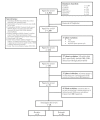Evaluating Patient Empowerment in Association With eHealth Technology: Scoping Review
- PMID: 28963090
- PMCID: PMC5640823
- DOI: 10.2196/jmir.7809
Evaluating Patient Empowerment in Association With eHealth Technology: Scoping Review
Abstract
Background: The prioritization of sustainable patient-centered care in contemporary health care has resulted in an increased focus on patient empowerment, which in turn is considered to facilitate patient independence, self-management, and self-efficacy. However, a definitional consensus of empowerment remains elusive, impeding efforts to translate the conceptual ideals of empowerment into a measurable entity associated with changes in health care behavior or outcomes. The rapid integration of technology in health care serves to add another layer of complexity in the measurability and operationalization of empowerment and helps to create a specific context in which this conceptual entity should be further examined.
Objective: The primary objective of this scoping review was to explore the concept of patient empowerment within the electronic health (eHealth) context. A further focus on the association or measurement of this concept in conjunction with tethered patient portal use was also employed.
Methods: In this scoping review, a six-step framework was used to guide the search and paper selection process. The review was initiated with two broad research questions, which are as follows: (1) What is the relationship between empowerment and the use of eHealth technologies from a patient perspective? (2) How is patient empowerment (and/or engagement or activation) influenced by accessing personal health information through a tethered patient portal? Multiple databases were employed in a comprehensive search strategy, and papers were primarily evaluated and selected for inclusion by 2 review authors, and a third author was consulted to resolve any issues in reaching consensus.
Results: From an initial count of 1387 publications, this review returned nine systematic or literature review papers and 19 empirical studies that pertained to patient empowerment (and/or engagement and activation) in relation to the use of tethered patient portals providing access to electronic health records (EHRs). Of the 19 empirical publications, only four were found to have used specific patient empowerment measures with significant variety in their identified conceptual elements.
Conclusions: There is a persistent lack of conceptual clarity in patient empowerment research, and this has extended to study within the eHealth context. The interchangeable use or conflation of terms such as patient empowerment, engagement, and activation, has further complicated the advancement of distinct conceptual measures. To more strongly align changes in patient empowerment with supportive eHealth solutions, the challenges of achieving a consensus on how best to operationalize and measure patient empowerment must be met.
Keywords: eHealth; measure; patient activation; patient empowerment; patient engagement; review.
©Tracie Risling, Juan Martinez, Jeremy Young, Nancy Thorp-Froslie. Originally published in the Journal of Medical Internet Research (http://www.jmir.org), 29.09.2017.
Conflict of interest statement
Conflicts of Interest: None declared.
Figures
Similar articles
-
Information and communication technology-enabled person-centered care for the "big five" chronic conditions: scoping review.J Med Internet Res. 2015 Mar 27;17(3):e77. doi: 10.2196/jmir.3687. J Med Internet Res. 2015. PMID: 25831199 Free PMC article.
-
Development and Evaluation of eHealth Services Regarding Accessibility: Scoping Literature Review.J Med Internet Res. 2023 Aug 17;25:e45118. doi: 10.2196/45118. J Med Internet Res. 2023. PMID: 37590050 Free PMC article.
-
Patient Portals Facilitating Engagement With Inpatient Electronic Medical Records: A Systematic Review.J Med Internet Res. 2019 Apr 11;21(4):e12779. doi: 10.2196/12779. J Med Internet Res. 2019. PMID: 30973347 Free PMC article.
-
Defining Empowerment and Supporting Engagement Using Patient Views From the Citizen Health Information Portal: Qualitative Study.JMIR Med Inform. 2018 Sep 10;6(3):e43. doi: 10.2196/medinform.8828. JMIR Med Inform. 2018. PMID: 30201603 Free PMC article.
-
The chronic care model and technological research and innovation: a scoping review at the crossroads.J Med Internet Res. 2015 Feb 6;17(2):e25. doi: 10.2196/jmir.3547. J Med Internet Res. 2015. PMID: 25677200 Free PMC article.
Cited by
-
Developing STEP-SE: A Qualitative Usability Study of a Novel Patient-Reported Outcomes Tool for Managing Side Effects in Shared Decision-Making for Schizophrenia Spectrum Disorder Care.Health Expect. 2024 Dec;27(6):e70019. doi: 10.1111/hex.70019. Health Expect. 2024. PMID: 39482944 Free PMC article.
-
Patient empowerment in Europe: is no further research needed?Eur J Health Econ. 2018 Jun;19(5):637-640. doi: 10.1007/s10198-018-0965-3. Eur J Health Econ. 2018. PMID: 29520521 No abstract available.
-
A Scale for Measuring Electronic Patient Engagement Behaviors: Development and Validation.Patient Prefer Adherence. 2024 Apr 25;18:917-929. doi: 10.2147/PPA.S444633. eCollection 2024. Patient Prefer Adherence. 2024. PMID: 38685912 Free PMC article.
-
Machine Learning-Based Prediction of Changes in the Clinical Condition of Patients With Complex Chronic Diseases: 2-Phase Pilot Prospective Single-Center Observational Study.JMIR Form Res. 2024 Apr 19;8:e52344. doi: 10.2196/52344. JMIR Form Res. 2024. PMID: 38640473 Free PMC article.
-
Patient Experiences With a Mobile Self-Care Solution for Low-Complex Orthopedic Injuries: Mixed Methods Study.JMIR Hum Factors. 2025 Mar 14;12:e53074. doi: 10.2196/53074. JMIR Hum Factors. 2025. PMID: 40085734 Free PMC article.
References
-
- Bravo P, Edwards A, Barr PJ, Scholl I, Elwyn G, McAllister M, Cochrane Healthcare Quality Research Group‚ Cardiff University Conceptualising patient empowerment: a mixed methods study. BMC Health Serv Res. 2015 Jul 01;15:252. doi: 10.1186/s12913-015-0907-z. https://bmchealthservres.biomedcentral.com/articles/10.1186/s12913-015-0... - DOI - DOI - PMC - PubMed
-
- Snowdon A, Alessi C, Schnarr K. sites.ivey.ca. 2014. [2017-01-31]. “It's all about me”: the personalization of health systems http://sites.ivey.ca/healthinnovation/files/2014/02/Its-All-About-Me-The... 6n3qZfWeH.
-
- McAllister M, Dunn G, Payne K, Davies L, Todd C. Patient empowerment: the need to consider it as a measurable patient-reported outcome for chronic conditions. BMC Health Serv Res. 2012 Jun 13;12:157. doi: 10.1186/1472-6963-12-157. https://bmchealthservres.biomedcentral.com/articles/10.1186/1472-6963-12... - DOI - DOI - PMC - PubMed
-
- Herbert RJ, Gagnon AJ, Rennick JE, O'Loughlin JL. A systematic review of questionnaires measuring health-related empowerment. Res Theory Nurs Pract. 2009;23(2):107–32. - PubMed
-
- Barr PJ, Scholl I, Bravo P, Faber MJ, Elwyn G, McAllister M. Assessment of patient empowerment--a systematic review of measures. PLoS One. 2015;10(5):e0126553. doi: 10.1371/journal.pone.0126553. http://dx.plos.org/10.1371/journal.pone.0126553 - DOI - DOI - PMC - PubMed
Publication types
MeSH terms
LinkOut - more resources
Full Text Sources
Other Literature Sources
Medical
Miscellaneous


